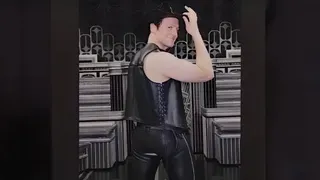June 21, 2011
Venice Biennale Explores Artistic Freedom
Robert Doyle READ TIME: 4 MIN.
VENICE, Italy (AP) - Outside the U.S. Pavilion, a runner pounds a treadmill on an overturned 60-ton military tank. The visually commanding exhibit at the 54th Biennale contemporary art exhibit reverberates - loudly.
At the Danish Pavilion nearby, a contemplative exhibition that explores free speech issues is periodically disturbed by the rumbles.
The juxtaposition of the booming Americans and the quiet Danes wasn't meant to make an artistic point - but the frictions caused perfectly capture one of the main themes of this year's Venice biennale: artistic freedom and its boundaries.
"It's a matter of negotiation," said artist Kobe Matthys, whose exhibit in the Danish pavilion backs onto the courtyard where the tank rests. "I don't mind the tank, because it's in the background. But it seems that all the videos pump up the volume to compete. The more silent works, they have to also manifest themselves."
Every second year, the contemporary art world converges on Venice to bask in its latest creations, a movable feast that requires patient navigation of the lagoon city's canals to reach the national pavilions, a main exhibit and dozens of side events. The Biennale opens Saturday to the public and runs through Nov. 27.
The main exhibit at the Arsenale, curated by Switzerland's Bice Curiger, is titled "IllumiNations." It seeks to integrate with the national pavilions by posing questions about national identity and art. It features 83 artists from all over the world.
This year, a record 89 countries have national pavilions, most in Venice's shaded Giardini, including for the first time Saudi Arabia, Bahrain, Rwanda, Bangladesh, Malaysia and tiny Andorra.
Just as telling, however, is who did not come. Bahrain and Lebanon withdrew at the last moment due to unrest at home. The impact of the uprisings sweeping the Middle East - from Tunisia to Libya to Syria - resonates strongly in Venice.
The Egyptian Pavilion presents the work of Ahmed Basiony, a new media and sound artist who was killed Jan. 28, on the third day of the popular uprising in Cairo's Tahir Square.
Basiony, a 32-year-old professor at the Helwan University in Cairo, was trying to film a sniper when he was struck twice by rubber bullets. He apparently keeled over, and was hit by a police car, said curator Aida Eltorie.
"He was that movement, that symbol of the majority. ... He was one of those people killed for the repression happening in Cairo for 30 years, maybe longer," Eltorie said.
The exhibit, conceived by Basiony's friend and fellow artist Shady El Noshokaty, features five screens projecting video Basiony recorded during the first days of the uprising, interposed with a project he made a year earlier called "Thirty Days Running in the Place."
The video of the uprising show the intensity of the protesters, engaged in earnest conversations, commenting about the high prices of lentils. In the running-in-place video, Basiony wears a hooded plastic suit and runs in place for an hour while sensors on the soles of his feet, under his arms and on his chest transmit data to a computer, which is run through a software program to create a digital display.
"He is tackling the idea of consumerism, being consumed and wasted," Eltorie said. "It was very much about his state of mind, and about what he felt about being an Egyptian."
At some pavilions artists spend months installing their works, but Basiony's friends won the Egyptian government's consent to feature his works just at the end of March. While grateful for the opportunity to share his work beyond his native Cairo, they are not yet convinced this heralds a new era of openness.
"There are no guarantees right now. We are in a transition now," Eltorie said.
Back at the U.S. Pavilion, a runner hops on the tank treadmill for a 15 minute jog every hour.
The project is part of six new works created by Jennifer Allora and Guillermo Calzadilla, artists who have collaborated since 1995, for the Biennale.
The exhibition is called "Gloria," which curator Lisa Frieman of the Indianapolis Museum of Art said evokes the ideas of the glory of God, and the glory of military battle.
Inside the pavilion, U.S. gymnasts perform routines on recreated business-class airline seats approximating a balance beam and a pommel horse.
Inspired by the pavilion's neoclassical architecture, which the artists said reminded them of a bank, they created an automatic teller machine installed beneath a set of specially commissioned German-built organ pipes, which bellow, melodically or ominously, in response to the language selection, pin code and withdrawal amount.
Spectators - who become participants when they insert their bank card - emit a joyful "Ohhh," when the ATM actually spits out euro bills.
The treadmill-tank combo "Track and Field" is by far the most attention-grabbing of the works.
"They are using an unexpected juxtaposition as a way to generate funny, unexpected results," said Freiman.
Among the unexpected results was the amount of noise it produced.
"I have to tell you, at the beginning, and this is so American, none of us knew the tank was going to be so loud. This is God's honest truth," Freiman said. Organizers immediately worried that it would be perceived as "typically American, loud and obnoxious."
"In fact," she said, "people love it."
Still, to help tone down the noise, the runner's pace has been slowed down.
Outside the Danish pavilion, curator Katerina Gregos laughs as the treadmill starts up in the middle of an interview. A Greek curator living in Brussels, Gregos has gathered artists from 11 countries to explore freedom of speech in an exhibit titled "Speech Matters." She also wanted to challenge the Biennale's concept of one nation, one artist.
"We have tried to be more contemplative," she said by discussing threats to free speech through the visual arts. "I think it is so important to discuss this now. We have long since entered a period of counter enlightenment, when hard-won civil liberties are under threat."
Long-term New Yorkers, Mark and Robert have also lived in San Francisco, Boston, Provincetown, D.C., Miami Beach and the south of France. The recipient of fellowships at MacDowell, Yaddo, and Blue Mountain Center, Mark is a PhD in American history and literature, as well as the author of the novels Wolfchild and My Hawaiian Penthouse. Robert is the producer of the documentary We Are All Children of God. Their work has appeared in numerous publications, as well as at : www.mrny.com.





